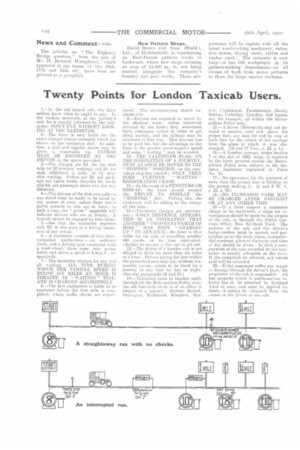Twenty Points for London Taxicab Users.
Page 12

Page 13

If you've noticed an error in this article please click here to report it so we can fix it.
1.—In the old horsed cab, the hirer seldom knew what he ought to pay. In the modern motorcab, at the journey's end, he is exactly informed by the taximeter. DON'T PAY WITHOUT LOOKING AT THE TAXIMETER.
2.—The hirer is only liable for the exact charges (extras included) which are shown on -the taximeter dial. In addition, a civil and capable driver may be given a reasonable lip. EXTRAS MUST BE RECORDED BY THE DRIVER in the space provided.
3.—The charges are Bd. for the first mile (or 10 minutes' waiting), and 2d. for
each additional mile, or 2 minutes waiting. Extras are 2d. per package not taken inside (bicycles 6d. each) and 6d. per passenger above Iwo (for any distance).
4.—The drivers of the first two cabs n any stand must be ready to he hired by any person at once, uliless these meti's police permits to rest are in force ; in such a case, the " point " constable will indicate drivers who are at liberty. A taxicab cannot be engaged by time alone. 5.—See that the taximeter registers only 8d. at the start of a hiring—exclusive of any extras.
6.—A taximeter consists of two interconnected mechanisms — an ordinary clock, and a driving gear connected with a road-wheel; these come into action below and above a speed of 6 m.p.h., respectively.
7.--The taximeter charges fur any and all waiting. ALL TIME DURING WHICH THE VEHICLE SPEED IS BELOW SIX MILES AN HOUR IS TREATED AS " WAITING" TIME, AND IS CHARGED ACCORDINGLY.
8.—The first eightpence is liable to be expended before the first mile is completed, where traffic checks are experi
enced. The accompanying sketch explains this. 9.—Drivers are required to travel by the shortest route, unless otherwise directed by the hirer ; they sometimes leave customary routes in order to get along quickly, and the mileage may be increased in this way. This increase has to be paid for, but the advantage to the hirer is the greater point-to-point speed and some " waiting ' may be avoided. 10.—THE TAXIMETER FLAG, ON THE COMPLETION OF A JOURNEY, MUST AT ONCE BE MOVED TO THE " STOPPED" POSITION—or the equivalent stop-kev turned; ONLY THEN DOES FURTHER " WAITING " REGISTRATION CEASE.
11.—In the event of a PUNCTURE OR MISHAP, the hirer should require the DRIVER TO DISPLAY the " STOPPED " disc. Failing this, the clockwork will be adding to the charge all the time.
12.—Taximeter charges are anticipatory; WHEN TEN PENCE APPEARS, THIS IS AN INTIMATION THAT ANOTHER "TWO P EN NY WORTH OF HIRE" HAS BEEN "CHARGED UP " IN ADVANCE; the hirer is then liable for the cost of travelling another 440 yards, or its time equivalent, whether he remain in the cab or get out.
13.—The driver of a London cab is riot, obliged to drive for more than six miles at a time. Drivers plying for hire within the prescribed area may not, without reawritable excuse, refuse to be hired for a journey at any time by day or night. (See also paragraphs 16 and 18.) 14.—Taximeter rates in London apply throughout. the Metropolitan Police area ; the old four-mile circle is of no effect. in respect of a taxicab. Staines, Barnet, Orpington, Richmond, Kingston, Her Chislehurst, Farnborough (Kent), Sutton, Uxbridge, Croydon, and Epsom are, for example, all within the Metropolitan Police area. 15.—A driver (Metropolis) may not demand or receive, over and above his proper fare, any sum for and by way of back fare for the return of his carriage from the place at which it was discharged. (16 and 17 Viet., c. 33, s. 4.) 16.—A London cabala'', under Section 7 of the Act of 1853, must, if required by the hirer, proceed outside the Metropolitan Police area, subject to the distance limitation explained in Point No. 13.
17.—No agreement for the payment of more than the proper fare is binding an the person making it. (1 and 2 W. 4, c. 22, s. 43.) 18.—NO INCREASED FARE MAY BE CHARGED AFTER MIDNIGHT OR AT ANY OTHER TIME.
19.—If a hirer suspect a taximeter charge to be inaccurate, a claim for investigation should be made to the owners of the cab, or through the Public Carriage Office, New Scotland Yard. The number of the cab and the driver's badge-number must be quoted, and particulars as to the route taken, taximeterdial readings, place of discharge and time of day should be given. In sum n a case, payment of the sum recorded on the taximeter is usually advisable at the time. If the complaint be allowed, any excess paid will be refunded.
20.—If the passenger suffer any injury or damage through the driver's fault, the proprietor of the cab is responsible. All lost property found in public-service vehicles has to be returned to Scotland Yard at once, and must be applied fot there; it cannot be obtained from the owner or the driver of the cab.
A Dunlop depot has been opened at 33, Leece Street, Liverpool.
Waring's Leyland.
The smart three-ton Leyland van, with 35-40 h.p engine, which we illustrate herewith. is owned by 'Waring and Gillow, Ltd., and is located at that company's Manchester branch. Mr. C. W. Cordner, the Manchester manager, writing to Leyland Motors, Ltd., on the 11th inst., stated: "We have now had your furniture van running continuously since 31st January last, and, up to the present, are very ‘vell satisfied with its capabilities. Should it maintain its present conduct, it will prove a very valuable acquisition to us in Manchester, where our deliveries are generally at some considerable distance. We beg to thank you for the care you took in carrying out the small special details required by us when building the van. This record promises to be maintained.






















